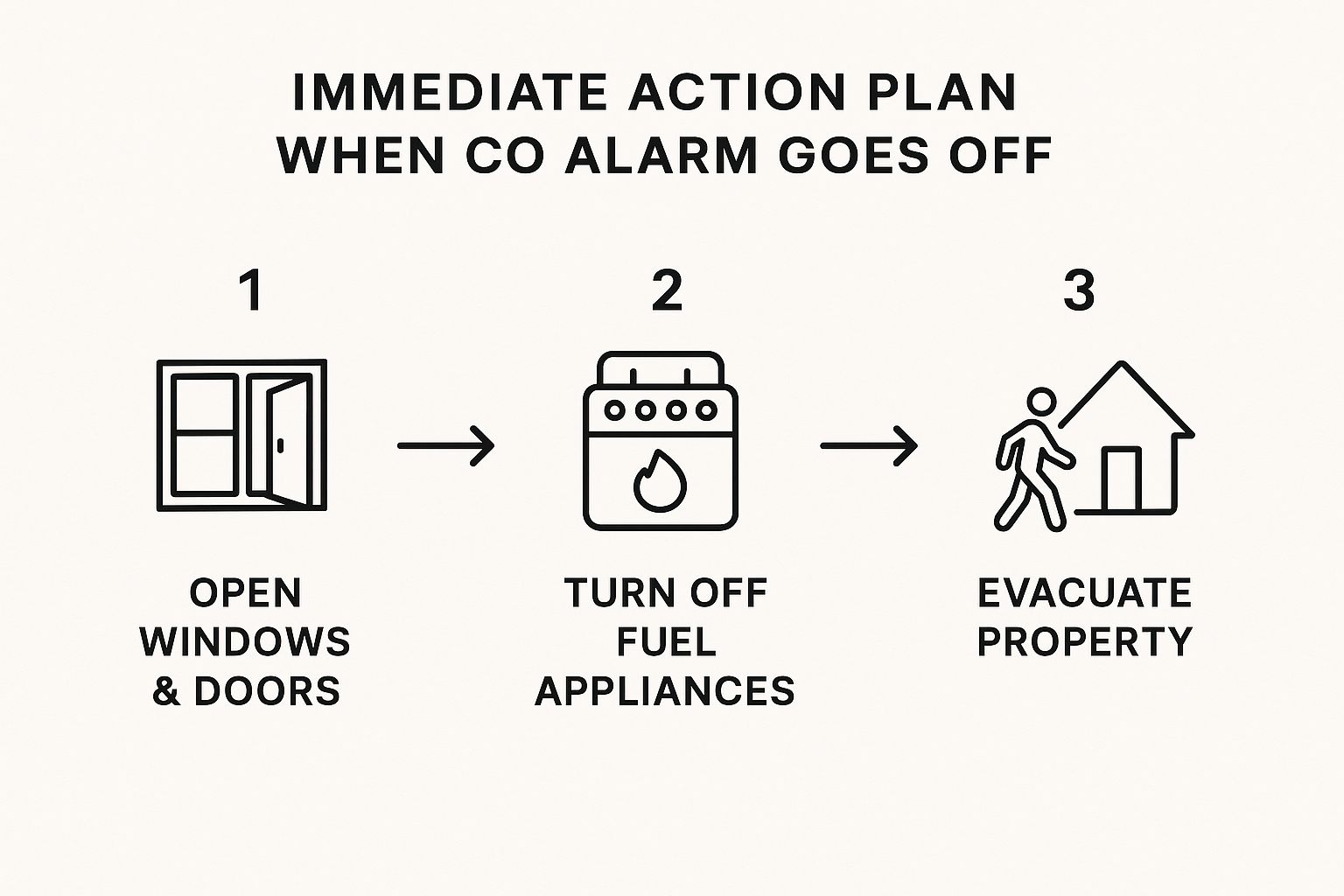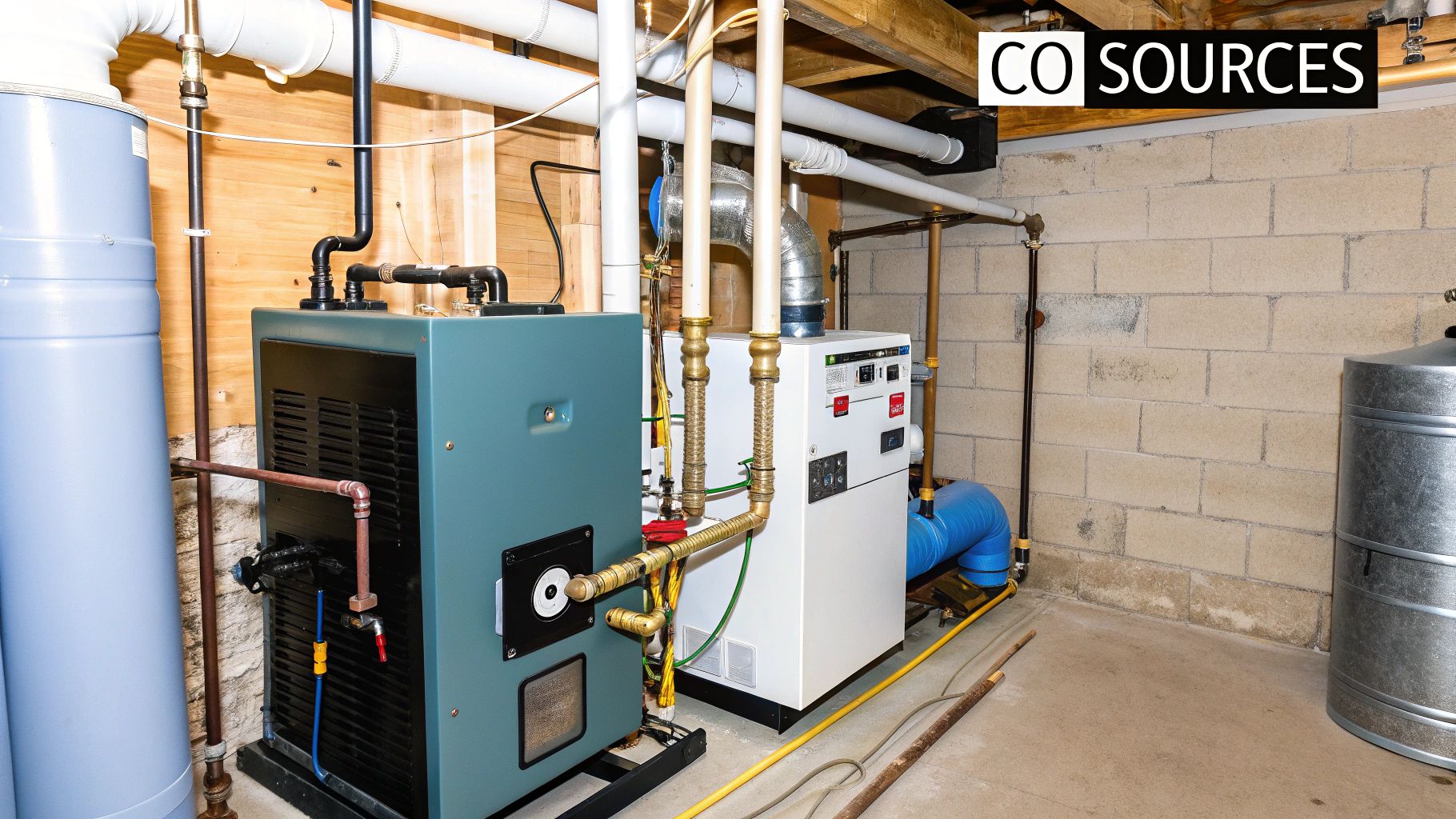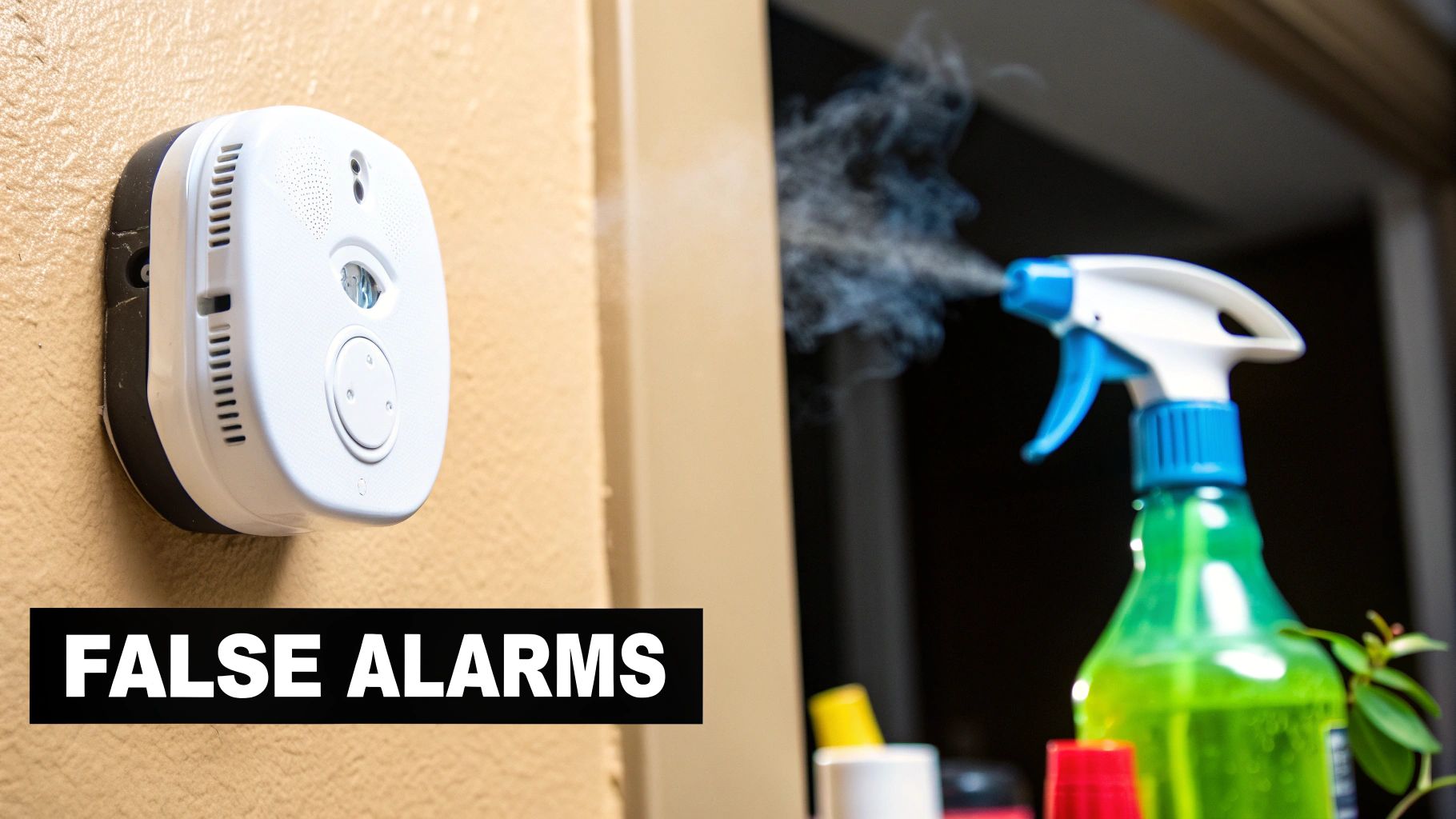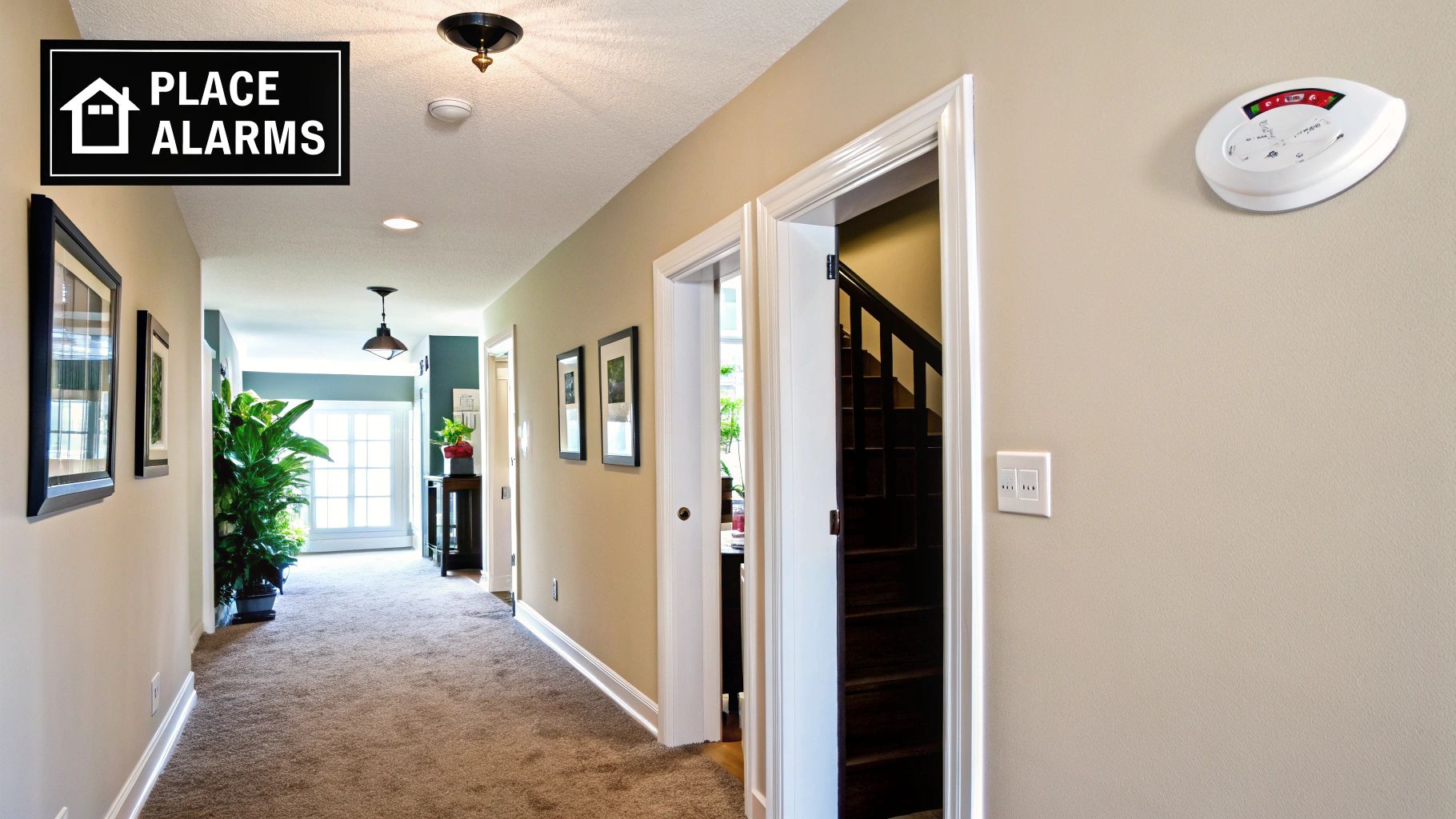Carbon Monoxide Alarm Goes Off What To Do
- Luke Yeates
- 4 days ago
- 13 min read
That piercing shriek from a carbon monoxide alarm is a sound you can't ignore. When it goes off, you need to treat it as a real emergency, every single time. The first thing to do is get fresh air into your home by opening all the windows and doors you can. Next, shut down any fuel-burning appliances—that means your boiler, gas hob, and anything similar. Most importantly, get everyone out of the house straight away.
Your Immediate Action Plan for a Sounding CO Alarm
The sound of a CO alarm is designed to cut through everything else for a very good reason. Carbon monoxide is completely invisible and has no smell, which makes this little device your only line of defence against a truly silent threat. Here at Harrlie Plumbing and Heating, we’ve been called out to homes across Eastbourne where a working alarm was the one thing that prevented a tragedy. Hesitating, even for a minute, is a risk you just can't take.
Your response needs to be automatic, like a practiced reflex. The main goals are simple: get everyone away from the potential danger and flood the property with fresh air as fast as you possibly can.
The Three Critical Safety Steps
As soon as you hear that alarm, follow these non-negotiable actions. Don't waste a second trying to find where the sound is coming from or wondering if the alarm is faulty.
Ventilate Immediately: Your very first move should be to open every window and door in the house. This helps break up any potential build-up of CO gas.
Shut Down the Sources: Without putting yourself in harm's way, switch off all potential fuel-burning appliances. This includes your gas boiler, gas fire, cooker, and any other equipment that uses fuel.
Evacuate Everyone: Get all people and pets out of the house and into the fresh air. Stay outside and do not go back in until either the emergency services or a Gas Safe registered engineer has given you the all-clear.
This flow chart gives you a quick visual reminder of the most critical things you need to do the moment your CO alarm starts screaming.

As you can see, the focus is squarely on getting out and getting air in, not trying to figure out the problem yourself.
Decoding Your Carbon Monoxide Alarm Sounds
It’s also really helpful to know what your alarm is trying to tell you. Not every sound is a full-blown emergency, but knowing the difference is key.
This quick table breaks down the common sounds you might hear.
Type of Sound | What It Means | Immediate Action Required |
|---|---|---|
Four loud, continuous beeps (repeating) | This is an emergency. Dangerous levels of carbon monoxide have been detected. | Yes. Evacuate immediately and call 999. |
One single chirp (every minute or so) | The battery is low and needs replacing. | No, but replace the batteries as soon as possible. |
Five chirps (every minute or so) | The alarm unit has reached the end of its life and needs to be replaced entirely. | No, but purchase and install a new alarm right away. |
Even with this guide, remember that your safety is what matters most.
Even if you just think it might be a fault, always, always err on the side of caution. Once you and your family are safely outside, call 999 and tell them you might have a carbon monoxide leak. The fire service can come out to assess the situation and check for CO levels.
After an incident, you'll want total peace of mind. A qualified Gas Safe engineer, like one from our team at Harrlie Plumbing and Heating in Eastbourne, can check your appliances thoroughly to ensure your home is safe.
For an even more comprehensive approach to home safety, you might find it useful to look at a broader emergency response plan template. It can help you make sure you’re prepared for any potential emergency at home.
Why Your CO Alarm Was Triggered
Once you’re safely outside and have called for help if needed, your mind will naturally start racing. Why did the alarm go off? Carbon monoxide (CO) is a nasty byproduct of incomplete combustion, meaning any appliance in your home that burns fuel like gas, oil, coal, or wood is a potential source.
In our experience across Eastbourne, from the lovely old terraces in Old Town to the modern builds in Sovereign Harbour, a faulty boiler is often the first thing people suspect. And they're frequently right. But it's far from the only possible cause, which is exactly why you should never, ever try to figure this out on your own.
Common Culprits Behind a CO Leak
A dangerous build-up of this invisible, odourless gas can happen for several reasons. It's often not just the appliance itself that's the problem, but the way it gets rid of its waste gases.
Here are some of the most common sources we at Harrlie Plumbing and Heating come across day in, day out:
Blocked Chimneys or Flues: It's amazing what can get stuck in there. Soot, leaves, debris, and even birds' nests can completely block the exit route for exhaust gases, forcing them right back into your living space.
Cracked Heat Exchangers: This is a serious fault inside a boiler or furnace. A crack can allow dangerous combustion gases to mix with the clean air that circulates through your home.
Poorly Maintained Appliances: Skipping your annual service isn't just about efficiency; it's a major safety issue. An unserviced appliance can burn fuel inefficiently, which is a direct cause of carbon monoxide production.
Improper Ventilation: Rooms with fuel-burning appliances need a good supply of fresh air to work correctly and vent fumes away. Blocked air bricks or poor ventilation can create a recipe for disaster.
We saw a stark reminder of this recently at a property in the Meads area of Eastbourne. The family's alarm went off in the middle of the night. When our Harrlie Plumbing and Heating engineer arrived, we found a huge bird's nest completely sealing off the boiler's flue. It was a silent, growing threat that only their CO alarm could detect.

Appliance Misuse and Installation Issues
Sometimes, the fault doesn't lie with the appliance at all, but with how it's being used or was installed in the first place. You’d be surprised how easily a hazardous situation can be created.
For instance, firing up a barbecue indoors or even too close to an open window can quickly fill a room with CO. The same goes for running a petrol lawnmower or generator in an attached garage—that gas can easily seep into the main house.
Dodgy installation work is another huge red flag. An improperly fitted appliance is an unsafe appliance. There are very specific risks of improper dryer venting, for example, like venting the exhaust into a loft space instead of outside, which can lead to a dangerous CO build-up.
Studies back this up, showing that gas appliances are a significant source of CO incidents. One found that 34.6% of alarm activations were due to faulty gas appliances, with another 10.6% caused by misusing cooking equipment.
Whatever you think the cause might be, the only safe move is to call in a professional. A Gas Safe registered engineer from a trusted local company like Harrlie Plumbing and Heating has the specialist equipment and training to pinpoint the source of the leak and, most importantly, tell you when it’s safe to go back inside.
Identifying False Alarms vs Real Dangers

When your carbon monoxide alarm goes off, the only safe response is to assume it's a real emergency. Once you've evacuated and aired out your home, you might start to wonder if it was a genuine danger or something less sinister. It’s a valid question, but one you should only ask once everyone is safely outside.
Sensitive CO alarms can sometimes be triggered by factors other than carbon monoxide. This doesn't mean they're faulty; it just means they've detected something in the air that mimics the conditions they are designed to sense. Understanding these potential triggers can help you troubleshoot after the immediate danger has passed.
Common Triggers for False Alarms
Once it's confirmed safe to re-enter your property, a bit of investigation can help you understand what happened. Sometimes, the cause is surprisingly simple.
High Humidity: Steam from a hot shower or a boiling kettle can occasionally set off an alarm, especially if it's located too close to a bathroom or kitchen. We often see this in compact Eastbourne flats where space is at a premium.
Aerosol Sprays: Hairspray, deodorant, or air fresheners release propellants and chemicals that can momentarily confuse a CO detector's sensor.
Chemical Fumes: Strong fumes from cleaning products, fresh paint, or solvents used during DIY projects are also common culprits.
Another crucial thing to check is the alarm's age. Every CO alarm has an expiry date, usually printed on the back. Most models have a lifespan of between five and ten years. An expired unit is unreliable and can lead to false alarms or, far worse, a failure to detect real danger.
The Golden Rule When In Doubt
Even after considering these possibilities, you might still feel uncertain. Was it just the steam from the shower, or is there an underlying issue with your boiler? This is where professional reassurance becomes invaluable.
The golden rule is simple: if you have any doubt whatsoever, it’s not worth the risk. A carbon monoxide alarm going off is too serious to leave to guesswork. Never assume it's a false alarm until a professional confirms it.
A quick call to a local Gas Safe team like Harrlie Plumbing & Heating is the safest next step. We can send a qualified engineer to your Eastbourne home to perform a thorough safety check. Our specialists use calibrated equipment to test the air for CO and inspect your appliances, like your boiler and gas hob, to ensure they are operating correctly.
This process not only identifies the source of an actual leak but also provides complete peace of mind if it was indeed a false alarm. For more detailed information on gas safety, you can learn how to detect gas leaks in our comprehensive homeowner's guide. This professional verification is the only way to be 100% sure your home is secure.
The Vital Role of Professional Gas Safety Checks
Honestly, the best way to deal with a carbon monoxide alarm that goes off is to make sure it never has a reason to in the first place. Being proactive with your gas appliances isn't just about keeping them running efficiently; it’s your single best line of defence against the silent threat of CO poisoning.
This is exactly where a professional gas safety check proves its worth. Regular, thorough servicing flips the script from a reactive state of panic to a preventative position of safety. It's all about catching and fixing the small issues before they have a chance to grow into life-threatening emergencies.
What a Harrlie Plumbing and Heating Check Involves
When one of our Gas Safe registered engineers visits a home in Eastbourne, whether it's a beautiful period property in Ratton or a new build down by the marina, we do far more than a quick look-see. A proper safety check is a meticulous process, designed from the ground up to ensure every part of your system is working correctly and, most importantly, safely.
Our engineers will methodically work through several crucial tests and inspections:
Appliance Operation Checks: We’ll make sure your boiler, gas fire, and cooker are all firing up and running at the correct operating pressure.
Flue and Ventilation Analysis: We inspect the flue for any blockages (we’ve seen our fair share of birds’ nests!) and check that there’s enough ventilation for the appliance to burn its fuel safely.
Combustion Gas Analysis: Using specialised, calibrated equipment, we analyse the waste gases coming from your appliance. This is a critical step that tells us if combustion is complete, confirming it isn't producing dangerous levels of carbon monoxide.
Flame and Burner Inspection: We’re looking for a stable, crisp blue flame. If we see a lazy, yellow, or orange flame, that’s a massive red flag for incomplete combustion and potential CO production.
Fixing Dangers Before They Start
It's not uncommon for our engineers to find and sort out issues that homeowners had no idea even existed. A partially blocked flue, for instance, might not cause any obvious problems you'd notice day-to-day, but it could be letting small amounts of CO silently seep into your home over a long period. Catching these hidden dangers is the whole point of a service.
The worrying truth is that carbon monoxide incidents are becoming a bigger concern. In London, for example, the number of suspected incidents more than doubled in just a few years. It’s a stark reminder from the London Fire Brigade about why these annual checks are so critical.
For us at Harrlie Plumbing and Heating, a gas safety check is the single most important service we offer. It’s not just about ticking a box for landlords; it's an essential part of responsible homeownership for everyone in Eastbourne.
By investing in an annual check, you aren't just maintaining your heating system; you are actively protecting your family from a completely preventable danger. If you'd like to understand the full scope of what's involved, you can learn more about [what a gas safety check for your home entails](https://www.harrlieplumbing.co.uk/post/what-is-a-gas-safety-check-for-your-home) in our detailed guide. It’s the ultimate peace of mind.
How to Choose and Position Your CO Alarms

Simply owning a CO alarm isn’t enough. For it to actually protect you if a carbon monoxide alarm goes off, you need the right type of unit, and it absolutely has to be in the correct spot. An alarm tucked away in the wrong place is almost as bad as having no alarm at all.
For homeowners here in Eastbourne, the first hurdle is selecting the right device. There's a lot of choice out there, but one non-negotiable feature you must look for is the British Standard kitemark.
Selecting the Right Alarm for Your Home
When you're browsing for an alarm, always check that it is marked with EN 50291. This is your guarantee that the device has been through rigorous testing and meets the strict safety and performance standards for domestic use. It’s a simple check that makes all the difference.
Next, you'll need to decide on a power source that works for your home:
Battery-Operated: These are the most common for a reason—they’re incredibly easy to install. You can place them practically anywhere, but you must be diligent about testing them and changing the batteries when needed.
Plug-In Models: Simple and effective, these plug directly into a wall socket. Most come with a battery backup for power cuts, but their placement is obviously limited by where your sockets are.
Hard-Wired Alarms: Often installed by professionals like our team at Harrlie Plumbing and Heating, these are wired directly into your home's electrical system. They're usually interconnected, which is a fantastic feature—if one sounds the alarm, they all do.
Where to Install Your CO Alarms for Maximum Safety
The placement of your alarms is just as crucial as the type you buy. Carbon monoxide is slightly lighter than air and tends to distribute evenly, so the old "high or low" debate isn't as important as making sure it's near potential sources and sleeping areas.
Follow these guidelines for the most effective placement:
One on Every Floor: At a bare minimum, you need an alarm on each level of your home.
Near Sleeping Areas: It's vital to place an alarm within three metres of the door to any room where someone sleeps. This ensures it's loud enough to wake them in an emergency.
Close to Appliances: Install an alarm between one and three metres away from any fuel-burning appliance, like your boiler, gas fire, or wood burner.
The UK has been a leader in mandating CO alarms, which has helped achieve one of the lowest CO mortality rates in Europe. Regulations in England and Wales have led to a rate of about 0.10 deaths per 100,000 people, but consistent placement and awareness are key to keeping families safe. Read more about how the UK measures up on carbon monoxide safety.
Places You Should Never Put a CO Alarm
Just as there are ideal spots, there are also locations that can cause annoying false alarms or, even worse, damage the unit's sensor and render it useless.
Steer clear of installing your alarm in these areas:
Directly above a heat source like a cooker or boiler.
In very dusty or dirty environments, such as a workshop or garage.
In humid areas like bathrooms or right next to a window where condensation builds up.
Proper selection and placement ensures your first line of defence against carbon monoxide is set up for success, ready to alert you when you need it most.
Got Questions About Carbon Monoxide Safety?
To wrap things up, let's go over some of the most common questions we hear from homeowners across Eastbourne. We get it—when a carbon monoxide alarm goes off, it’s a genuinely frightening experience. Our goal at Harrlie Plumbing and Heating is to give you clear, reliable answers that will help keep your family safe.
How Often Should I Be Testing My CO Alarm?
This is a fantastic question, and the answer is simple: test your CO alarm at least once a month. It's a quick job that takes just a few seconds. Simply press and hold the 'test' button on the unit until you hear the alarm shriek to life. This quick check confirms the battery, circuitry, and the sounder are all working as they should.
An easy way to remember is to tie it into another monthly routine, like testing your smoke alarms or paying a specific bill. Making it a regular habit is the best way to ensure it never gets forgotten. An untested alarm is as good as no alarm at all.
Are Modern Boilers Still a Carbon Monoxide Risk?
Yes, absolutely. While it's true that modern boilers are built to incredibly high safety standards—with features like sealed combustion chambers and automatic shut-offs—they are not infallible. Any fuel-burning appliance, no matter how new, can become a risk if it’s not correctly installed, properly ventilated, or regularly maintained.
For example, a brand-new boiler fitted in an Eastbourne home could still produce CO if its flue becomes blocked by autumn leaves or a bird's nest. That’s why an annual service by a Gas Safe engineer isn’t just a recommendation; it's a critical safety measure for any boiler, old or new.
Never assume a new appliance is automatically safe. Regular, professional maintenance is the only way to guarantee your boiler is operating correctly and protecting you from the silent threat of carbon monoxide.
What Are the Physical Symptoms of CO Poisoning?
Knowing the symptoms of CO poisoning is vital, especially since they are so easily mistaken for other common illnesses like the flu. Because carbon monoxide is odourless and invisible, feeling unwell might be the only warning sign you get if your alarm fails.
Be on the lookout for these common signs:
Headaches: Often described as a dull, persistent tension-type headache.
Dizziness and Nausea: Feeling lightheaded, sick to your stomach, or generally confused.
Breathlessness and Chest Pains: You might notice difficulty breathing or a tightness in your chest.
Collapse or Loss of Consciousness: In cases of high exposure, this can happen terrifyingly quickly.
If several people in your home (including pets!) suddenly feel unwell with these symptoms at the same time, you must treat CO poisoning as a real possibility and act immediately.
If your carbon monoxide alarm has gone off, or you have any worries about the safety of your gas appliances, don't leave it to chance. Harrlie Plumbing and Heating provides emergency call-outs and professional Gas Safe checks across Eastbourne and the surrounding areas. Contact us today for complete peace of mind: https://www.harrlieplumbing.co.uk
